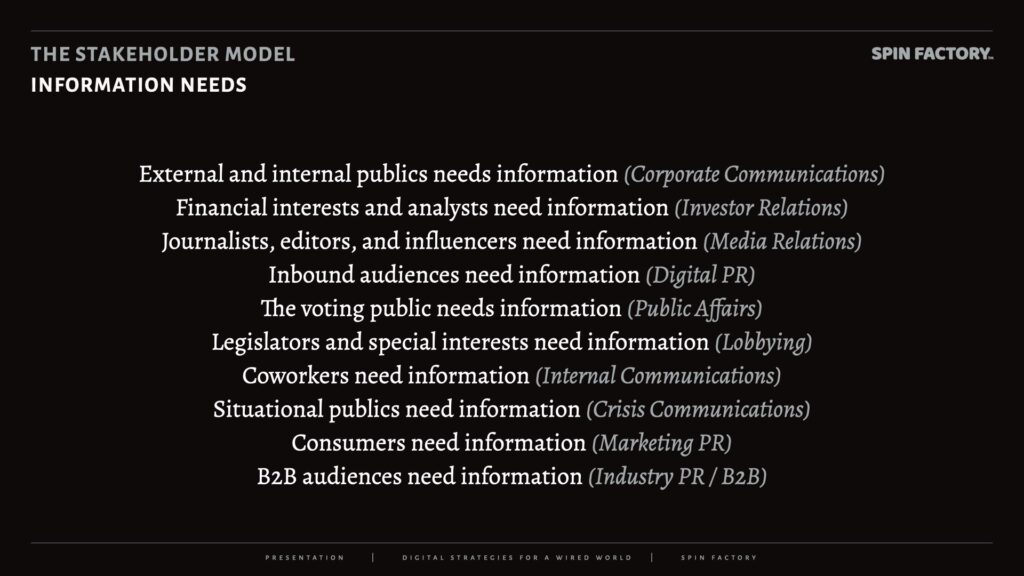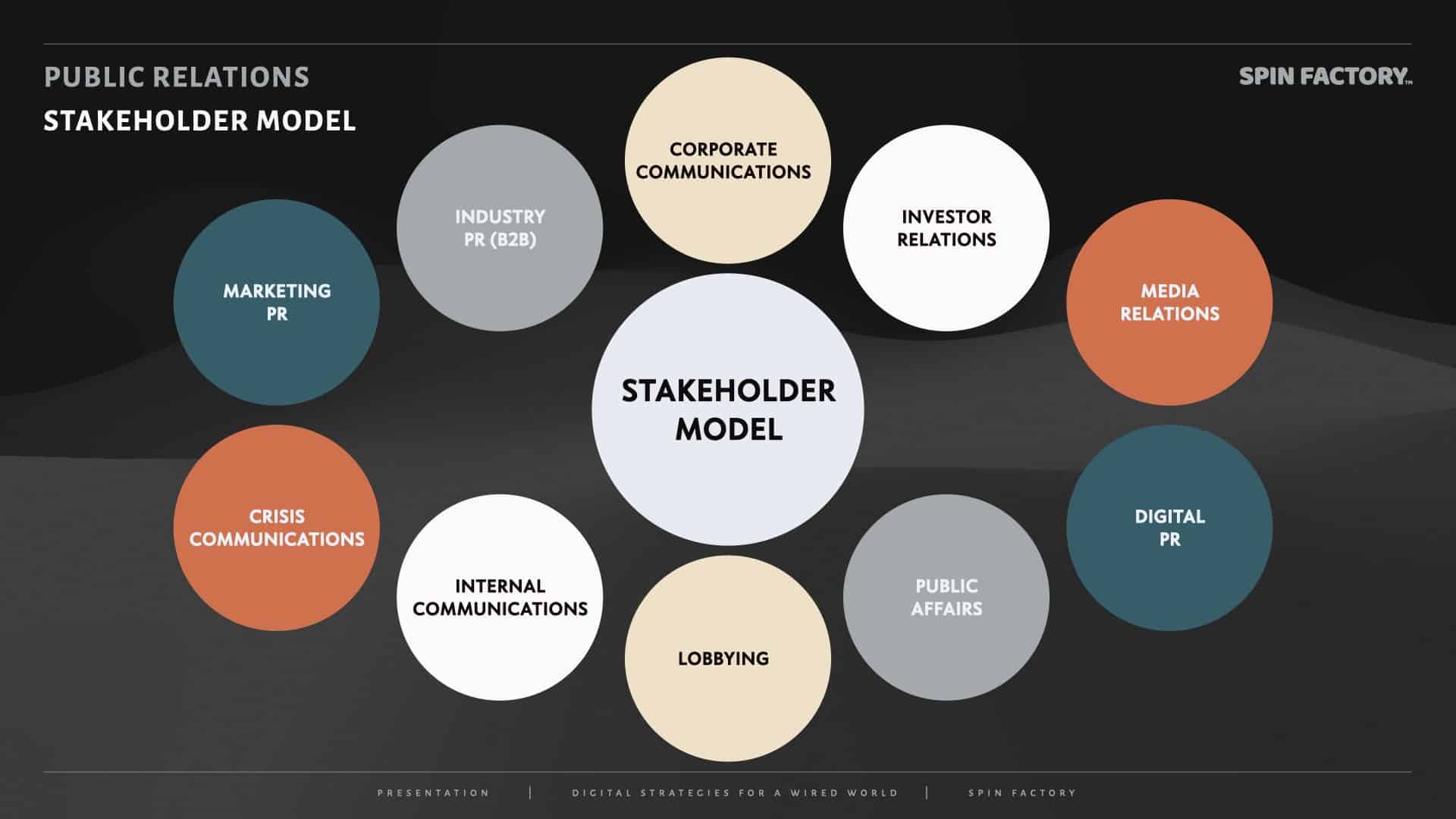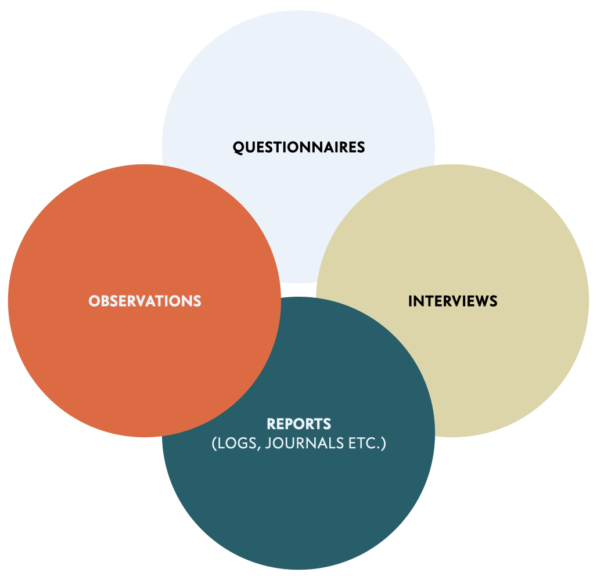ROI and PR are like oil and water — they don’t mix well.
Having worked in the PR industry for many years, I know how inflammatory such a statement might be.
Many PR professionals and academics dream of a future where our industry can showcase our worth by demonstrating concrete ROI results.
Maybe we’re wrong?
The Basic PR Model
To get us started, let’s look at a basic stakeholder model for public relations:
The Stakeholders in Public Relations
In public relations (PR), we often discuss stakeholders:
Stakeholders = representatives of various vested interests directly or indirectly connected to a brand. 1Silfwer, J. (2021, January 5). The Stakeholders in Public Relations. Doctor Spin | The PR Blog. https://doctorspin.net/stakeholders-in-public-relations/
The PR function is not just about managing media relations or marketing PR; it’s about comprehensively managing relationships with diverse stakeholder groups, each with unique information needs.
Different Information Needs
Why are stakeholders so important in PR?
Marketing is typically tasked with increasing an organisation’s sales of products and services. However, many other information needs must also be met.

Establishing and sustaining relationships with various stakeholders is a significant challenge for PR professionals since their information needs are typically very different.
This requires understanding each stakeholder’s situational perspective, interests, and communication preferences.
The challenge for PR professionals is effectively identifying and addressing these varied needs. It involves crafting tailored communication strategies that resonate with each stakeholder group while maintaining a cohesive core message that aligns with the PR objectives.
“Public relations distinguishes itself from marketing by focusing on the stakeholder-organization relationship, which comprises mutual orientation around a common interest point and a multiplicity of stakes.”
Source: Public Relations Review 2Smith, B. (2012). Public relations identity and the stakeholder – organization relationship: A revised theoretical position for public relations scholarship. Public Relations Review, 38, 838 – 845. … Continue reading
The PR Stakeholder Model
PR professionals have various specialisations (based on the stakeholder model), including corporate communications, investor relations (IR), media relations, digital PR, public affairs (PA), lobbying, internal communications (IC), crisis communications, marketing PR, and industry PR (B2B).

“In a corporation, a stakeholder is a member of ‘groups without whose support the organisation would cease to exist’, as defined in the first usage of the word in a 1963 internal memorandum at the Stanford Research Institute. The theory was later developed and championed by R. Edward Freeman in the 1980s. Since then it has gained wide acceptance in business practice and in theorising relating to strategic management, corporate governance, business purpose and corporate social responsibility (CSR).”
Source: Wikipedia 3Stakeholder (corporate). (2023, October 27). In Wikipedia. https://en.wikipedia.org/wiki/Stakeholder_(corporate)
PR Specialisations (Based on Stakeholders)
PR specialisations are typically named based on which stakeholder type they manage:
Corporate communications = an organisation’s strategic use of messaging to shape its reputation, articulate its vision, and engage with key audiences across internal and external channels.
Targets: External and internal publics, business journalists, regulatory institutions, partners, suppliers, vendors, etc.
Investor relations (IR) = an organisation’s deliberate communication efforts to build trust and maintain transparency with investors, analysts, and the financial community.
Targets: Shareholders, investors, market hubs, market analysts, financial institutions, trade journalists etc.
Media relations = a brand’s targeted use of communication to foster positive interactions with journalists, editors, and media outlets and to gain favourable coverage.
Targets: Journalists, editors, influencers, etc.
Digital PR = the strategic use of online communication to build brand communities, foster engagement, and manage reputation in the digital space. 4Silfwer, J. (2017, November 20). What is Digital PR? Doctor Spin | The PR Blog. https://doctorspin.net/what-is-digital-pr/
Targets: Inbound web traffic, brand communities, subscribers, fans, followers, influencers, social networks, etc.
Public affairs (PA) = a brand’s intentional use of communication to engage with governments, policymakers, and communities to influence public policy and social impact.
Targets: Voters, political journalists, political analysts, columnists, interest groups, etc.
Lobbying = the focused use of advocacy and communication to directly influence legislative and regulatory decisions in favour of specific interests or causes.
Targets: Politicians, legislators, government officials, committees, influencers, etc.
Internal communications (IC) = an organisation’s deliberate use of messaging to align, inform, and motivate employees while fostering a productive workplace culture.
Targets: Coworkers, potential recruits, etc.
Crisis communications = a brand’s rapid, strategic deployment of communication to mitigate reputational damage, address urgent challenges, and restore public trust during critical situations.
Targets: Crisis victims, worried publics, the general public, coworkers, journalists, influencers, customers, shareholders, etc.
Marketing PR = a brand’s tactical integration of communication and promotional efforts to enhance product awareness, drive sales, and support marketing objectives.
Targets: Potential customers, existing customers, trade journalists, members, affiliates, etc.
Industry PR (B2B) = a business’s purposeful use of communication to build credibility, foster trust, and establish thought leadership within its professional sector.
Targets: B2B clients, B2B prospects, trade journalists, trade organisations, niche influencers, etc.
Learn more: Stakeholders in Public Relations
Without getting too hung up on establishing an exact definition of PR, the value of PR can be seen as the total value of all the relationships mentioned above.
ROI in Marketing vs PR
With the basic PR model in mind, let me make a distinct point:
If an organisation invests nothing in marketing, there’s no marketing.
If an organisation invests nothing in PR, there’s still PR.
Or another way to put it:
No investments in marketing = the return on marketing is zero.
No investments in PR = the return of PR is still a number.
So, does PR work for the ROI definition?
ROI = net income/cost of investment
It should be evident that the basic ROI model lacks fundamental variables to be useful for PR.
Need more convincing? Let’s keep going.
Two Unsolvable Problems
Can’t we make the ROI model work anyway?
Perhaps we can balance the net incomes (beforet0 and aftert1 the PR investment)?
Like this:
ROI = (net incomet1 — net incomet0) / cost of investment
There are severe problems with this approach:
One problem is that the return on the PR investment is a fluctuating valuation rather than a net income; it’s not “money in the bank.”
This creates an imbalance in the formula:
ROI = (valuationt1 — valuationt0) / cash loss
The next problem is establishing validity; how could we ever calculate the value of t=1 if the organisation never made those PR investments?
Example:
An organisation faces a severe crisis, but the PR function manages the situation ideally and minimises the loss of a) net income and b) brand value.
To calculate the value of the investment, we must know how severely the crisis would’ve impacted the organisation without the PR investment. Unless you find a way to visit parallel timelines, there’s no way of finding this out.
And even if we find a method of approximation, there’s still an actual loss of value — which puts the ROI in the red.
The Oil and Water Analogy
So, what does all of this mean in a practical sense?
It means that ROI and PR are like oil and water.
They don’t mix well.
Those who don’t appreciate my initial logic may instead consider that we’ve been trying to establish ROI for PR since the start of our profession — without success.
Our lack of progress forces us to consider the alternatives:
Either ROI or PR don’t mix.
Or we’re just too stupid to make it work.
Or, we accept that PR requires a specific ROI model that shouldn’t be compared. This means, for instance, that an organisation can’t benchmark the general ROI model of marketing against the particular ROI model of PR because it’s… apples and pears.
ROI and PR: A Fork in the Road
“Insanity is doing the same thing over and over and expecting different results.”
— Albert Einstein
If my suggested logic does not convince you, or if you think I’m mischaracterising or over-simplifying the practice of establishing ROI, that’s fine.
Regardless, we’re still left at a fork in the PR road:
a) If we’re all about apples and pears, we can keep discussing the ROI of PR academically, but it’ll be useless in practice.
b) If we’ve been too stupid this far, we’ll have to keep trying — and perhaps get more competent people to join our ranks.
c) Or, we could decide that enough is enough, cut our losses and start focusing on something with a better potential of being useful.
How To Demonstrate PR Value
For my preferred option c) above, I’d suggest the following principles for establishing the value of investing in PR activities:
Measuring Attitudes and Behaviours
How To Measure Public Relations
How do you measure public relations (PR)? I recommend measuring attitudes and behaviours using questionnaires, rating scales, interviews, reports (logs, journals, diaries, etc.), and observations.

The general recommendation for PR measurement: I recommend the sociological method for getting valuable and actionable results from measuring public relations. This means measuring attitudes and behaviours. 5Silfwer, J. (2021, March 4). Methods of Measuring Public Relations. Doctor Spin | The PR Blog. https://doctorspin.net/measuring-public-relations/
Attitude Measurements in PR
There are a few things to consider when measuring attitudes and behaviours correctly. 6Educational Communications and Technology. (2001, August 3). 34.5 Measuring Attitudes. The Handbook of Research for Educational Communications and Technology. … Continue reading
An attitude measurement should meet the following criteria:
There are four main types of attitude measurement approaches:
There are four main types of attitude measurement methods:
Learn more: How To Measure Public Relations
Still not convinced? I accept that.
As noted above, I’m not naïve enough to believe that one short blog post could resolve one of our industry’s most challenging dilemmas.
However, I do want to close with this:
By clinging to the ROI model, we represent the PR function at the C‑level by demonstrating how much net income we generate for organisations.
Mark my words: This is a battle we’ll never win.
Instead, we must demonstrate how we’re increasing shareholder value, creating room for the organisation to grow, mitigating potential losses, and safeguarding future revenue.
Any boardroom would be mad not to invite such a PR function.

THANKS FOR READING.
Need PR help? Hire me here.

Annotations
| 1 | Silfwer, J. (2021, January 5). The Stakeholders in Public Relations. Doctor Spin | The PR Blog. https://doctorspin.net/stakeholders-in-public-relations/ |
|---|---|
| 2 | Smith, B. (2012). Public relations identity and the stakeholder – organization relationship: A revised theoretical position for public relations scholarship. Public Relations Review, 38, 838 – 845. https://doi.org/10.1016/J.PUBREV.2012.06.011 |
| 3 | Stakeholder (corporate). (2023, October 27). In Wikipedia. https://en.wikipedia.org/wiki/Stakeholder_(corporate) |
| 4 | Silfwer, J. (2017, November 20). What is Digital PR? Doctor Spin | The PR Blog. https://doctorspin.net/what-is-digital-pr/ |
| 5 | Silfwer, J. (2021, March 4). Methods of Measuring Public Relations. Doctor Spin | The PR Blog. https://doctorspin.net/measuring-public-relations/ |
| 6 | Educational Communications and Technology. (2001, August 3). 34.5 Measuring Attitudes. The Handbook of Research for Educational Communications and Technology. https://members.aect.org/edtech/ed1/34/34 – 05.html |


